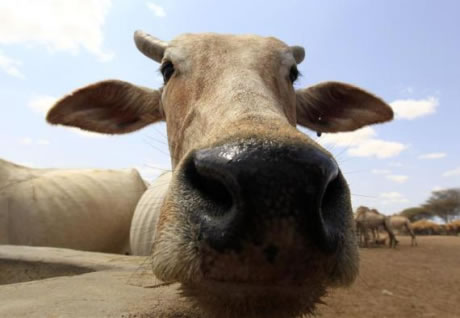
Tuesday, May 08, 2012
By Katy Migiro

A cow is seen after drinking water from a wadi in the Kenya-Somalia border town of Liboi July 29, 2011. REUTERS/Thomas Mukoya
LODWAR (AlertNet) – Livestock could turn Kenya’s drought-stricken northern lands into an engine of job creation, rather than a sinkhole for emergency aid, the minister for the region has said.Almost 4 million Kenyans needed food aid in early 2012 following a devastating drought the previous year. Many communities were left destitute as their cattle, sheep and goats were wiped out.
“The potential of livestock has not even been touched a little,” Mohamed Elmi, minister for Northern Kenya and other arid lands, told AlertNet in an interview.
“In North Eastern (Province) alone, if the Kenya market was made more efficient it would create 400,000 jobs.”
He was referring to the epicentre of last year’s crisis, which borders Somalia and Ethiopia, where people traditionally keep animals on drylands that cannot support arable farming.
Kenya is a meat‐deficit country. A 2008 paper by the International Livestock Research Institute suggested the 400,000 jobs could be created if half of that domestic deficit were to be met by increased livestock production from North Eastern Province.
Northern Kenya has experienced four major droughts in the last decade, and their frequency and severity appear to be increasing.
The government is now in the final stages of finalising a 10-year strategy paper aimed at transforming the arid and semi-arid lands that occupy over 80 percent of Kenya. Current plans include constructing abattoirs and improving infrastructure.
BETTER ROADS NEEDED
Livestock already contributes to almost half of Kenya’s agricultural gross domestic product (GDP).
With the right investment, Elmi believes, Kenya could export vast quantities of meat to regional markets.
“If we got only 5 percent of the Middle East market, it would create across the country 2.5 million jobs,” he said.
Kenya’s largest abattoir is 30km outside the capital, Nairobi, more than 500 km from the pastoralist heartlands. By the time drought-stricken animals reach the slaughterhouse, they are often little more than skin and bone.
The government hopes to finish constructing five new abattoirs in pastoral areas next year in Isiolo, Wajir, Garissa, West Pokot and the southern rangelands, Elmi said. These will make it much easier for livestock owners to sell their animals for a good price when they are still healthy.
But building up the meat industry would require improved roads and marketing, too, he said.
Northern Kenya region covers close to 400,000 square km (154,441 square miles) of land but has less than 700 km of tarmac road, most of which is in disrepair. The mobile phone network is limited to major towns and only one county, Isiolo, is connected to the national electricity grid.
This makes it difficult for pastoralists to sell their livestock to national and regional markets.
The government estimates that it would cost $1 billion to provide climate-proof roads, water, irrigation and energy infrastructure to northern Kenya over the next decade.
This compares to the estimated $12 billion lost in damages and losses during the 2008 to 2011 drought, according to government figures.
“It will reduce the impact of the droughts and also bring quite an income to the country,” Elmi said of the potential of livestock.